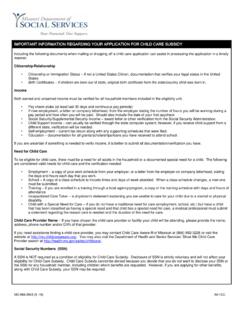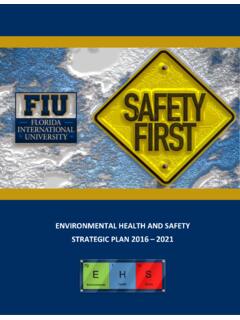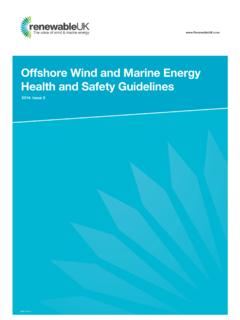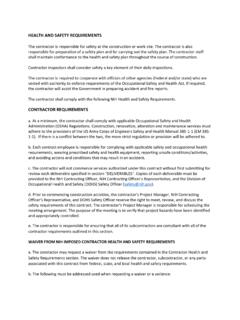Transcription of The Child Care & Development Fund (CCDF) Health and …
1 The Child Care & Development Fund (CCDF) Health and Safety Training Closed Captioning Slide 1 Before you begin this online training module, please consider the following: Make sure your computer speakers are on, before continuing. Closed captioning has been made available for this training. Click on the attachment icon to open it. This training will take approximately two hours to complete, and you may pause or go back, by clicking the appropriate buttons. This training should be taken outside of business hours so you can concentrate on the content of the course. This training should be completed in Internet Explorer version 7 or newer as it may not be fully compatible with other internet browsers.
2 Click when you are ready to get started. Slide 2 Welcome to the Child Care and Development Fund (CCDF) Health and Safety Training. This training is presented by the Missouri Department of Social Services, Children's Division, Early Childhood and Prevention Services. Slide 3 On November 19, 2014, President Obama signed into law bipartisan legislation that reauthorized the Child Care and Development Block Grant Act for the first time since 1996. The law made many important statutory changes focused on reforming Child care in this country to better support the success of both parents and children in low-income families and increase their access to healthy, safe, high quality Child care.
3 The CCDBG Act is the law, (along with Section 418 of the Social Security Act) that authorizes the federal Child care subsidy program known as Child Care and Development Fund (CCDF).The final rule published by Health and Human Services updates the CCDF regulations to provide detail and clarification based on the law. Specifically, the rule sets up new guidelines designed to ensure that children will be in safer, higher-quality care that supports their healthy growth and Development and that providers receive training to meet the needs of the children in their care. This training covers the minimum Health and safety training requirements for Child care providers serving children receiving assistance through the CCDF program EXCEPT Pediatric first aid and cardiopulmonary resuscitation.
4 Slide 4 By the end of this training, you should be able to: Explain the purpose of the minimum Health and safety training requirements for Child care providers; Build knowledge and skills around best practices in Child care regarding the Health and safety requirements of the Child Care and Development Block Grant Act; and Apply your knowledge to ensure that children will be in safer, higher-quality care that supports their healthy growth and Development . Slide 5 The minimum Health and safety training requirements are based on the following categories: First Aid and CPR; Prevention of Sudden Infant Death Syndrome and Use of Safe Sleep Practices; Prevention of Shaken Baby Syndrome and abusive head trauma; Emergency Preparedness and response planning; Mandatory Child abuse and neglect reporting; Prevention and Control of Infectious Diseases, including Immunizations; Administration of Medication, Consistent with Standards for Parental Consent; Prevention and Response to Allergy Emergencies; Building and physical premises safety.
5 Handling and storage of hazardous materials and the Appropriate Disposal of Bio Contaminants; and The Transportation of Children. The rest of this training course will focus on the specifics of each category. Click when you are ready to continue. Slide 6 Staff trained in pediatric first aid, including pediatric cardiopulmonary resuscitation (CPR) can lessen the consequences of injury, and reduce the potential for death from life-threatening conditions. Knowledge of pediatric first aid, including pediatric CPR, which addresses management of a blocked airway and rescue breathing, and the confidence to use these skills, are critically important to the outcome of an emergency situation.
6 All staff members involved in providing direct care to children should have up-to-date documentation of satisfactory completion of training in pediatric first aid and CPR skills. The First Aid/CPR certification does not have to be done through the Missouri Workshop Calendar. First Aid/CPR certificates are accepted from the following national models: American Academy of Pediatrics Peed Facts American Red Cross American Heart Association American Safety and Health Institute E M S Safety National Safety Council Emergency Care and Safety Institute ProTrainings The Missouri Workshop Calendar First Aid/CPR Tab lists companies and organizations throughout Missouri that offer First Aid and CPR training.
7 Costs will vary by training provider. All staff must maintain a valid CPR certification when working in a state contracted or registered Child care facility or home. First aid and CPR skills should be current according to the requirement specified for retraining by the organization that provided the training. Slide 7 As a parent or caregiver, it is important to be sure your baby s sleep environment is a safe one. All caregivers should follow safe sleep practices as recommended by the American Academy of Pediatrics (AAP) to reduce the risk of sudden unexpected infant deaths. According to the Centers for Disease Control and Prevention, in 2015, there were about 3,700 sudden unexpected infant deaths in the United States.
8 Sudden unexpected infant death (SUID) is the death of an infant less than 1 year of age that occurs suddenly and unexpectedly, and whose cause of death is not immediately obvious before investigation. Most SUIDs are reported as one of three types: o Sudden infant death syndrome (SIDS) cannot be explained after a thorough investigation. o Unknown cause undetermined because one or more parts of an investigation was not completed. o Accidental suffocation and strangulation in bed suffocation by soft bedding, rolling over on or against the infant, wedging or entrapment between two objects, or for example, when an infant s head is caught between crib railings.
9 O The sudden, unexplained death of an infant is a tragic family event. Because the cause is often unknown, safe sleep practices should be used to reduce the risk of sudden unexpected infant deaths in every infant under the age of one year. Safe sleep is as simple as ABC. Babies should: o Sleep Alone o On their Backs o In a Crib The American Academy of Pediatrics evidence-based recommendations include: o Place the baby on his or her back to sleep alone, for naps and night time. o Place the baby in a safety-approved crib, bassinet or portable play area with a firm sleep surface and fitted sheet. Do not place the baby to sleep on an adult bed or other soft mattress, waterbed, sofa, chair, beanbag, bouncy seat, swing, or in a car seat.
10 O Remove all soft objects, toys, blankets, bumper pads, and pillows from the sleep area. o Dress the baby in a sleeper or sleep sack instead of using a blanket or other covering. o Put the baby to sleep alone in a crib or bassinet, but in the same room where you sleep. Bed sharing is dangerous. The baby may be brought into bed for feeding, but should be returned to his or her own sleep area when finished. o Additional risks include: Smoke exposure during pregnancy and after birth Alcohol and illicit drug use during pregnancy and after birth Overheating and head covering of the infant Using wedges or positioners to prop an infant While babies should always be placed on their back to sleep, they need to be put on their stomach to play under active supervision by an adult.




